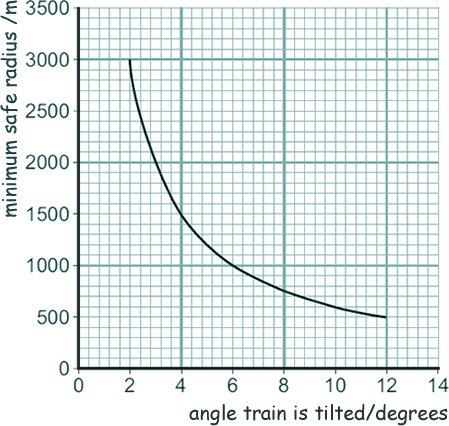GCSE Questions: Circular Motion
Q2. The diagram below shows two train tracks, A and B.

(a)
(i) A train moves at constant speed along track A. Explain how the train can be accelerating while travelling at a constant speed.
Veolcity has two parts - speed and direction. Although the speed is constant the direction is changing  therefore the velocity is changing
therefore the velocity is changing and a change in velocity is termed acceleration.
and a change in velocity is termed acceleration.
[3 marks]
(ii) Two identical trains travel on the tracks, one on track A and one on track B. Explain which train can travel at the highest maximum speed.
Track B has a larger radius  allowing the train to travel at a greater speed for a given centripetal force.
allowing the train to travel at a greater speed for a given centripetal force.
[2 marks]
(b) One type of train is designed to tilt as it goes around bends. Tilting the train more increases the centripetal force that acts on the train.
(i) Suggest one advantage of creating a train which can vary the amount it tilts as it goes around bends.
The train can go faster round bends without toppling over. 
[1 mark]
(ii) The tilting train is designed so that the line of action of the weight of the train always lies between the two rails. State why the train does not topple.
There is no (resultant) moment. 
[1 mark]
(c) An engineer built a small scale model to predict the minimum safe radius of curved track that the tilted train could safely go round at 250 km/hour.
The results predicted using the small scale model are shown in the following graph.

(i) The engineer described the relationship between the angle that the train tilted and the minimum safe radius at 250 km/hour as inversely proportional.
Use data from the graph to explain why the engineer is correct.
Either
When the angle doubles the radius halves. (An explanation using numbers quoted from the graph to support this eg at 2 degrees the minimum radius is 3000 m but at 4 degrees it is 1500 m. )
(An explanation using numbers quoted from the graph to support this eg at 2 degrees the minimum radius is 3000 m but at 4 degrees it is 1500 m. )
Or
The product of angle and radius is constant  - the product is 6000 m degrees - eg at 2 degrees the minimum radius is 3000 m we get 2 x 3000 = 6000 and at 4 degrees it is 1500 m and 4 x 1500 = 6000.
- the product is 6000 m degrees - eg at 2 degrees the minimum radius is 3000 m we get 2 x 3000 = 6000 and at 4 degrees it is 1500 m and 4 x 1500 = 6000.
[2 marks]
(ii) The engineer also created a computer simulation of the tilting train.
Suggest one benefit of using a computer simulation over using a small scale model.
Any one from: 
A computer simulation allows for more variables to be tested
A computer simulation can control variables more easily
A computer simulation can generate lots of results in a short time
A computer simulation does not get damaged in test runs
[1 mark]
[10 Marks TOTAL]








